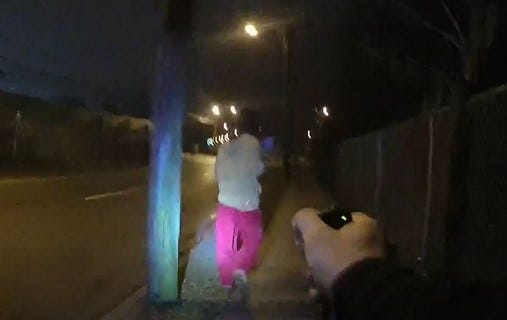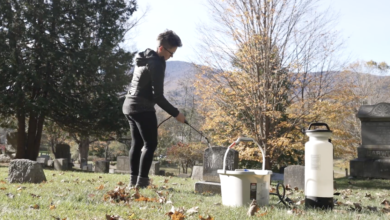
Body camera video from the arrest of an autistic man who has sued Cincinnati police, alleging officers used excessive force and detained him for no reason, shows the man ignored numerous commands.
The video shows Officer Weston Voss point a Taser at Brandon Davis and shout, "Stop! Stop!" Davis looked back but continued to walk down the sidewalk during the late-night encounter. Davis also didn't obey Voss's partner, Emily Heine, when she shouted at him to stop.
The video also shows the officers told Davis several times not to reach into his pocket.
And according to what the officers said in the video, which was obtained by The Enquirer through a public records request, Davis resisted putting his hands behind his back.
"He's resisting," Voss said before directing Heine to use her Taser.
The February 2019 incident is at the center of a federal lawsuit filed by Davis early this month. Davis, now 33, has never been convicted of a crime. According to the lawsuit, he was walking from a friend’s apartment to the home in Millvale he shares with his mother. It says he was following a safety plan he’d arranged with his mother. The lawsuit says that because of Davis’ hypersensitivity to sensory input, he became overwhelmed by the flashing lights from the police cruiser and noise.
The lawsuit says the officers fabricated reasons for stopping him. The video shows the officers believed they had seen him walking through a park, the Wayne Recreation Area, after hours. It’s known by police as a high-crime area. Documents put the time at 11:17 p.m.
In the video, Davis told the officers more than 20 times that he was never in the park.
One of Davis's attorneys, Jacqueline Green, said the officers stopped Davis even though they had no reasonable suspicion to justify it. The apartment building he'd left was next to the park, Green said, and Davis had walked down the driveway to the sidewalk.
"What they actually did was accost a man who was doing nothing more than walking down the sidewalk," she said. "And they did it very, very aggressively."
The incident began after the officers stopped their police cruiser near the intersection of Beekman Street and Dreman Avenue, and Heine told Davis they wanted to talk to him.
“We want to talk about what you were doing in that park over there,” Heine said.
Davis, who at that point was standing on the sidewalk, responded, “I didn’t do nothing.”
“The park was closed," Voss said. "We just need to get your information."
“I wasn’t chillin’ in the park,” Davis said as he began walking away from the officers.
Voss told him they saw him cutting through the park.
“Sir, you are not free to leave,” Voss said, before pulling out his Taser and aiming it at Davis.

What followed was Voss repeatedly warning Davis that he would use his Taser and Davis continuing to walk away. Both Voss and Heine shouted at Davis to stop, but he didn’t. Voss told him several times not to reach into his pocket.
At one point, Voss said, “I don’t want to tase you.”
Davis kept saying that he wasn’t in the park and told the officers, “I didn’t do nothing.”
The lawsuit says that even if he had been in the park, it “would not have provided legal justification" for the way the officers responded.
Eventually, Voss shoved Davis against a chain-link fence, and a struggle began, with Voss telling Davis, “Give me your hands” and Heine asking if he was holding something. Voss told Davis repeatedly to put his hands behind his back.
During the struggle, Davis said they had “the wrong person – I wasn’t coming through no park.”
Both Voss and Heine warned him that he would be “tased” if he continued to struggle.
Three and a half minutes after they first encountered Davis, Voss told Heine to use her Taser on Davis’ top right shoulder. Voss told her Davis was "resisting."
Heine used her Taser several times in "drive stun mode," pressing it against Davis, who screamed in pain as Voss took him, face down, to the sidewalk. Green said the use of the Taser can prevent someone from being able to control their own body.
Davis was jailed for a night and charged with resisting arrest, being in a park after dark and jaywalking. A jury later acquitted him of all charges.
The police union’s president released a statement after the lawsuit was filed, saying prosecutors agreed that the body camera video and other facts justified misdemeanor charges. An internal investigation found that Voss and Heine acted appropriately and only used force when it was necessary, according to the statement.
Green said the way Heine and Voss handled the situation went against the department's own policies on de-escalation.
"This entire situation was crated by Heine and Voss, and there was no justification for it, from beginning to end," she said.
Source link








